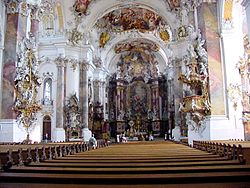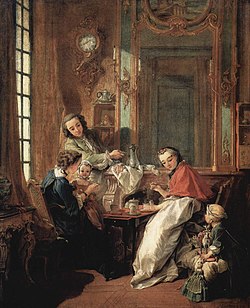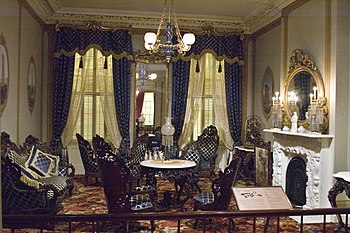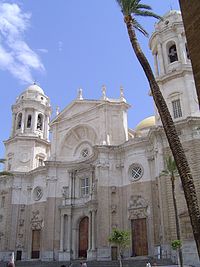Rococo
From Wikipedia, the free encyclopedia
| This article does not cite any references or sources. Please help improve this article by adding citations to reliable sources (ideally, using inline citations). Unsourced material may be challenged and removed. (May 2008) |
Rococo is a style of 18th century French art and interior design. Rococo rooms were designed as total works of art with elegant and ornate furniture, small sculptures, ornamental mirrors, and tapestry complementing architecture, reliefs, and wall paintings. It was largely supplanted by the Neoclassic style.
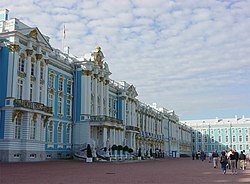
The word Rococo is seen as a combination of the French rocaille, or stone garden (refering to arranging stones in natural forms like shells), and the Italian barocco, or Baroque style. Due to Rococo love of shell-like curves and focus on decorative arts, some critics used the term to derogatively imply that the style was frivolous or merely modish; interestingly, when the term was first used in English in about 1836, it was a colloquialism meaning "old-fashioned". However, since the mid 19th century, the term has been accepted by art historians. While there is still some debate about the historical significance of the style to art in general, Rococo is now widely recognized as a major period in the development of European art.
Contents |
[edit] Historical development
Rococo developed first in the decorative arts and interior design. Louis XV's succession brought a change in the court artists and general artistic fashion. By the end of the old king's reign, rich Baroque designs were giving way to lighter elements with more curves and natural patterns. These elements are obvious in the architectural designs of Nicolas Pineau. During the Régence, court life moved away from Versailles and this artistic change became well established, first in the royal palace and then throughout French high society. The delicacy and playfulness of Rococo designs is often seen as perfectly in tune with the excesses of Louis XV's regime.
The 1730s represented the height of Rococo development in France. The style had spread beyond architecture and furniture to painting and sculpture, exemplified by the works of Antoine Watteau and François Boucher. Rococo still maintained the Baroque taste for complex forms and intricate patterns, but by this point, it had begun to integrate a variety of diverse characteristics, including a taste for Oriental designs and asymmetric compositions.
The Rococo style spread with French artists and engraved publications. It was readily received in the Catholic parts of Germany, Bohemia, and Austria, where it was merged with the lively German Baroque traditions. German Rococo was applied with enthusiasm to churches and palaces, particularly in the south, while Frederician Rococo developed in the Kingdom of Prussia. Architects often draped their interiors in clouds of fluffy white stucco. In Italy, the late Baroque styles of Borromini and Guarini set the tone for Rococo in Turin, Venice, Naples and Sicily, while the arts in Tuscany and Rome remained more wedded tlp Baroque.
In England Rococo was always thought of as the "French taste" and was never widely adopted as an architectural style, although its influence was strongly felt in such areas as silverwork, porcelain, and silks, and Thomas Chippendale transformed English furniture design through his adaptation and refinement of the style. William Hogarth helped develop a theoretical foundation for Rococo beauty. Though not intentionally referencing the movement, he argued in his Analysis of Beauty (1753) that the undulating lines and S-curves prominent in Rococo were the basis for grace and beauty in art or nature (unlike the straight line or the circle in Classicism). The development of Rococo in England is considered to have been connected with the revival of interest in Gothic architecture early in the 18th century.
The beginning of the end for Rococo came in the early 1760s as figures like Voltaire and Jacques-François Blondel began to voice their criticism of the superficiality and degeneracy of the art. Blondel decried the "ridiculous jumble of shells, dragons, reeds, palm-trees and plants" in contemporary interiors[1]. By 1785, Rococo had passed out of fashion in France, replaced by the order and seriousness of Neoclassical artists like Jacques Louis David. In Germany, late 18th century Rococo was riduculed as Zopf und Perücke ("pigtail and periwig"), and this phase is sometimes referred to as Zopfstil. Rococo remained popular in the provinces and in Italy, until the second phase of neoclassicism, "Empire style," arrived with Napoleonic governments and swept Rococo away.
There was a renewed interest in the Rococo style between 1820 and 1870. The English were among the first to revive the "Louis XIV style" as it was miscalled at first, and paid inflated prices for second-hand Rococo luxury goods that could scarcely be sold in Paris. But prominent artists like Delacroix and patrons like Empress Eugénie also rediscovered the value of grace and playfulness in art and design.
[edit] Rococo in different artistic modes
[edit] Furniture and decorative objects
The lighthearted themes and intricate designs of Rococo presented themselves best at a smaller scale than the imposing Baroque architecture and sculpture. It is not surprising, then, that French Rococo art was at home indoors. Metalwork, porcelain figures,frills and especially furniture rose to new pre-eminence as the French upper classes sought to outfit their homes in the now fashionable style.
Rococo style took pleasure in asymmetry, a taste that was new to European style. This practice of leaving elements unbalanced for effect is called contraste.
During the Rococo period, furniture was lighthearted, physically and visually. The idea of furniture had evolved to a symbol of status and took on a role in comfort and versatility. Furniture could be easily moved around for gatherings, and many specialized forms came to be such as the fauteuil chair, the voyeuse chair, and the berger en gondola. Changes in design of these chairs ranges from cushioned detached arms, lengthening of the cushioned back (also known as "hammerhead") and a loose seat cushion. Furniture was also freestanding, instead of being anchored by the wall, to accentuate the lighthearted atmosphere and versatility of each piece. Mahogany was widely used in furniture construction due to its strength, resulting in the absence of the stretcher as seen on many chairs of the time. Also, the use of mirrors hung above mantels became ever more popular in light of the development of unblemished glass.
In a full-blown Rococo design, like the Table d'appartement (ca. 1730), by German designer J. A. Meissonnier, working in Paris (illustration, below), any reference to tectonic form is gone: even the marble slab top is shaped. Apron, legs, stretcher have all been seamlessly integrated into a flow of opposed c-scrolls and "rocaille." The knot (noeud) of the stretcher shows the asymmetrical "contraste" that was a Rococo innovation.
Most widely admired and displayed in the "minor" and decorative arts its detractors claimed that its tendency to depart from or obscure traditionally recognised forms and structures rendered it unsuitable for larger scale projects and disqualified it as a fully architectural style.
Dynasties of Parisian ébénistes, some of them German-born, developed a style of surfaces curved in three dimensions (bombé), where matched veneers (marquetry temporarily being in eclipse) or vernis martin japanning was effortlessly complemented by gilt-bronze ("ormolu") mounts: Antoine Gaudreau, Charles Cressent, Jean-Pierre Latz, François Oeben, Bernard II van Risenbergh are the outstanding names.
French designers like François de Cuvilliés, Nicholas Pineau and Bartolomeo Rastrelli exported Parisian styles in person to Munich and Saint Petersburg, while the German Juste-Aurèle Meissonier found his career at Paris. The guiding spirits of the Parisian rococo were a small group of marchands-merciers, the forerunners of modern decorators, led by Simon-Philippenis Poirier.
In France the style remained somewhat more reserved, since the ornaments were mostly of wood, or, after the fashion of wood-carving, less robust and naturalistic and less exuberant in the mixture of natural with artificial forms of all kinds (e.g. plant motives, stalactitic representations, grotesques, masks, implements of various professions, badges, paintings, precious stones).
English Rococo tended to be more restrained. Thomas Chippendale's furniture designs kept the curves and feel, but stopped short of the French heights of whimsy. The most successful exponent of English Rococo was probably Thomas Johnson, a gifted carver and furniture designer working in London in the mid 1700s.
[edit] Interior design

Solitude Palace in Stuttgart and Chinese Palace in Oranienbaum, the Bavarian church of Wies and Sanssouci in Potsdam are examples of how Rococo made its way into European architecture.
In those Continental contexts where Rococo is fully in control, sportive, fantastic, and sculptured forms are expressed with abstract ornament using flaming, leafy or shell-like textures in asymmetrical sweeps and flourishes and broken curves; intimate Rococo interiors suppress architectonic divisions of architrave, frieze and cornice for the picturesque, the curious, and the whimsical, expressed in plastic materials like carved wood and above all stucco (as in the work of the Wessobrunner School). Walls, ceiling, furniture, and works of metal and porcelain present a unified ensemble. The Rococo palette is softer and paler than the rich primary colors and dark tonalities favored in Baroque tastes.
A few anti-architectural hints rapidly evolved into full-blown Rococo at the end of the 1720s and began to affect interiors and decorative arts throughout Europe. The richest forms of German Rococo are in Catholic Germany (illustration, above).
Rococo plasterwork by immigrant Italian-Swiss artists like Bagutti and Artari is a feature of houses by James Gibbs, and the Franchini brothers working in Ireland equalled anything that was attempted in England.
Inaugurated in some rooms in Versailles, it unfolds its magnificence in several Parisian buildings (especially the Hôtel Soubise). In Germany, French and German artists (Cuvilliés, Neumann, Knobelsdorff, etc.) effected the dignified equipment of the Amalienburg near Munich, and the castles of Würzburg, Potsdam, Charlottenburg, Brühl, Bruchsal, Solitude (Stuttgart), and Schönbrunn.
In England, one of Hogarth's set of paintings forming a melodramatic morality tale titled Marriage à la Mode, engraved in 1745, shows the parade rooms of a stylish London house, in which the only rococo is in plasterwork of the salon's ceiling. Palladian architecture is in control. Here, on the Kentian mantel, the crowd of Chinese vases and mandarins are satirically rendered as hideous little monstrosities, and the Rococo wall clock is a jumble of leafy branches.
In general, Rococo is an entirely interior style, because the wealthy and aristocratic moved back to Paris from Versailles. Paris was already built up and so rather than engaging in major architectural additions, they simply renovated the interiors of the existing buildings.
[edit] Painting

Though Rococo originated in the purely decorative arts, the style showed clearly in painting. These painters used delicate colors and curving forms, decorating their canvases with cherubs and myths of love. Portraiture was also popular among Rococo painters. Some works show a sort of naughtiness or impurity in the behavior of their subjects, showing the historical trend of departing away from the Baroque's church/state orientation. Landscapes were pastoral and often depicted the leisurely outings of aristocratic couples.
Jean-Antoine Watteau (1684–1721) is generally considered the first great Rococo painter. He had a great influence on later painters, including François Boucher (1703–1770) and Jean-Honoré Fragonard (1732–1806), two masters of the late period. Even Thomas Gainsborough's (1727–1788) delicate touch and sensitivity are reflective of the Rococo spirit. Élisabeth-Louise Vigée-Le Brun's (1755-1842) style also shows a great deal of Rococo influence, particularly in her portraits of Marie Antoinette.
[edit] Gallery of Rococo painting
|
The Swing, Jean-Honoré Fragonard, 1767 |
|||
[edit] Sculpture
Sculpture was another area where the Rococo was widely adopted. Étienne-Maurice Falconet (1716–1791) is widely considered one of the best representatives of French Rococo. In general, this style was best expressed through delicate porcelain sculpture rather than imposing marble statues. Falconet himself was director of a famous porcelain factory at Sèvres. The themes of love and gaiety were reflected in sculpture, as were elements of nature, curving lines and asymmetry.
The sculptor Bouchardon represented Cupid engaged in carving his darts of love from the club of Hercules; this serves as an excellent symbol of the Rococo style—the demigod is transformed into the soft child, the bone-shattering club becomes the heart-scathing arrows, just as marble is so freely replaced by stucco. In this connection, the French sculptors, Robert Le Lorrain, Michel Clodion, and Pigalle may be mentioned in passing.
[edit] Music
The Galante Style was the equivalent of Rococo in music history, too, between Baroque and Classical, and it is not easy to define in words. The rococo music style itself developed out of baroque music, particularly in France. It can be characterized as intimate music with extremely refined decoration forms. Exemplars include Jean Philippe Rameau and Louis-Claude Daquin.
Boucher's painting (above) provides a glimpse of the society which Rococo reflected. "Courtly" would be pretentious in this upper bourgeois circle, yet the man's gesture is gallant. The stylish but cozy interior, the informal decorous intimacy of people's manners, the curious and delightful details everywhere one turns one's eye, the luxury of sipping chocolate: all are "galante."
[edit] Rococo "worldliness" and the Roman Catholic Church
An interesting illustration of the hostility sometimes aroused by this style (similar to that of early Modernists to High Victorian style) can be found in the critical view of Rococo taken by the 1913 Catholic Encyclopedia, especially on the unsuitable nature of Rococo for ecclesiastical contexts.[1]
[edit] Gallery
|
Library of the Mafra National Palace |
Hints of Rococo can be discerned in the churches by the Brazilian master Aleijadinho |
Czapski Palace in Warsaw (1712-1721) |
St.Andrew's Church in Kiev designed by Francesco Bartolomeo Rastrelli |
[edit] See also
- Rococo in Portugal
- Queluz National Palace
- Cultural movement
- Cathedral of Murcia
- Gilded woodcarving
- History of painting
[edit] Notes
[edit] External links
| Wikimedia Commons has media related to: Rococo |
- Examples
- Rococo in the "History of Art"
- "Rococo Style Guide". British Galleries. Victoria and Albert Museum. http://www.vam.ac.uk/vastatic/microsites/british_galleries/bg_styles/Style04a/index.html. Retrieved on 2007-07-16.
[edit] Further reading
- Fiske Kimball, 1943. Creation of the Rococo (Reprinted as The Creation of the Rococo Decorative Style, 1980).
- Arno Schönberger and Halldor Soehner, 1960. The Age of Rococo Published in the US as The Rococo Age: Art and Civilization of the 18th Century (Originally published in German, 1959).
- Michael Levey, 1980. Painting in Eighteenth-Century Venice, (Revised edition).
- Pal Kelemen, 1967. Baroque and Rococo in Latin America, (2nd edition).
|
||||||||||||||

